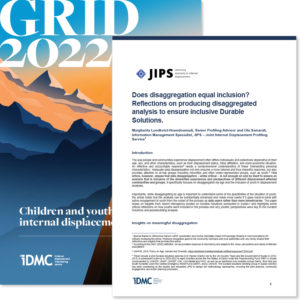
This background paper is JIPS’ contribution to the 2022 Global Report on Internal Displacement, issued each year by the Internal Displacement Monitoring Centre (IDMC).
The way people and communities experience displacement often differs individually and collectively depending on their age, sex, and other characteristics, such as their displacement status, tribal affiliation, and socio-economic situation. An effective and accountable response needs a comprehensive understanding of these ‘intersecting personal characteristics.’ Adequate data disaggregation not only ensures a more tailored and thus impactful response, but also provides attention to at-risk groups including minorities and often under-represented groups, such as youth. This paper, however, argues that data disaggregation – while critical – is not enough on and by itself to ensure an analysis that is inclusive of the diversified experiences and perspectives of different displacement-affected communities and groups; it specifically focuses on disaggregation by age and the inclusion of youth in displacement analyses.
Importantly, while disaggregating by age is important to understand some of the specificities of the situation of youth, the article holds that the analysis can be substantially enhanced and made more useful if it goes hand-in-hand with active engagement of youth from the outset of the process as data users rather than mere beneficiaries. The paper draws on insights from recent interagency studies on Durable Solutions conducted in Sudan, and highlights some critical reflections on how youths were included in the process and why youths’ perspectives were key to the Durable Solutions and peacebuilding analysis.
Key messages from the background paper: